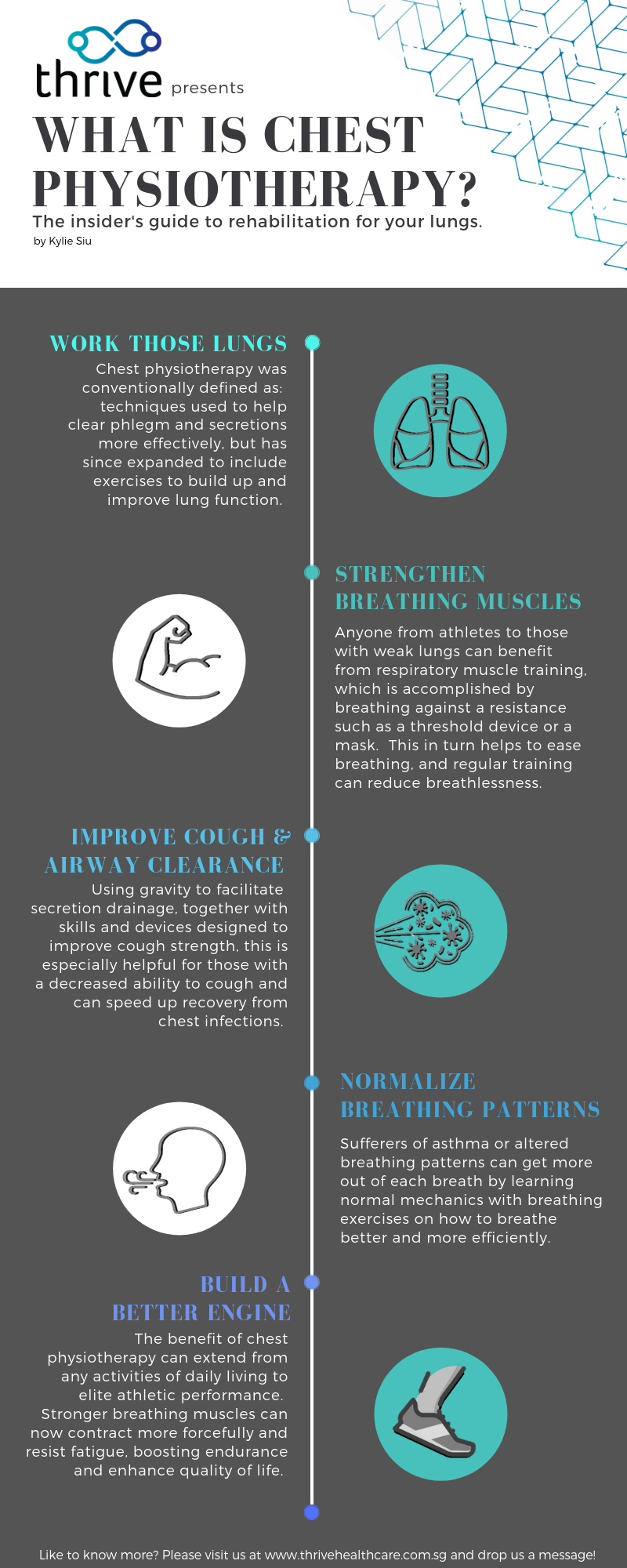What on Earth is Chest Physiotherapy?
- Kylie Siu

- May 23, 2019
- 3 min read
Updated: Sep 12, 2025
So what is it?
Chest physiotherapy was conventionally defined as techniques used to help clear phlegm and secretions more effectively but has since expanded to include exercises to build up and improve lung function.
The purpose of chest physiotherapy is:
To facilitate removal of retained or profuse airway secretions.
To optimize lung compliance and prevent it from collapsing.
To decrease the work of breathing.
To optimize the ventilation-perfusion ratio/ improve gas exchange.
Normal airway clearance involves coughing, but when the mechanism of mucus clearance is affected due to issues such as a disease, various techniques must be employed to aid in airway clearance.
Who needs it?
Anyone from athletes to those with weak lungs can benefit from respiratory muscle training, which is accomplished by breathing against a resistance such as a threshold device or a mask. This in turn helps to ease breathing, and regular training can reduce breathlessness.
Sufferers of asthma or altered breathing patterns can get more out of each breath by learning normal mechanics with breathing exercises on how to breathe better and more efficiently.
How does it work?
Gravity is used to facilitate secretion drainage, together with skills and devices designed to improve cough strength, this is especially helpful for those with a decreased ability to cough and can speed up recovery from chest infections.
Build a Better Engine!
The benefit of chest physiotherapy can extend from any activities of daily living to elite athletic performance. Stronger breathing muscles can now contract more forcefully and resist fatigue, boosting endurance and enhance one's quality of life.

What Does Chest Physiotherapy Do?
Chest physiotherapy techniques (or some countries, respiratory physiotherapy) was conventionally defined as treatments used to help clear phlegm and secretions more effectively, but has since expanded to include exercises to build up and improve lung function.
There are many chest physiotherapy techniques, but let us first begin by listing how chest physiotherapy can help with various conditions.
"I turn breathless easily."
Inspiratory muscle training will be useful for you
Anyone from athletes to those with weak lungs can benefit from respiratory muscle training, which is accomplished by performing breathing exercises against a resistance such as a threshold device or a mask. This in turn helps to ease breathing, and regular training can reduce breathlessness. Chest physiotherapy is also useful to help in treating conditions such as long COVID, cystic fibrosis and COPD.
"It's hard to cough out my phlegm."
Expiratory muscle training will be useful for you
An experienced clinician who does chest physiotherapy will be able to select from a spectrum of techniques such as different chest physiotherapy positions, postural drainage, percussions and vibrations, together with skills and devices such as the cough assist machine designed to improve coughing strength and remove mucus/phlegm from the lungs, and is especially helpful for those with a decreased ability to cough and can speed up recovery from various chest complications.
"I struggle to take deep breaths."
Relearning breathing mechanics will be useful for you
Sufferers of asthma could have irregular breathing patterns, which can cause an individual to get more out of each breath by learning normal mechanics with breathing exercises on how to breathe better and more efficiently.
" I want to increase my endurance."
Strengthen your lungs with Chest Physiotherapy
The benefit of chest physiotherapy can extend from any activities of daily living to elite athletic performance. Stronger breathing muscles can now contract more forcefully and resist fatigue, boosting endurance and enhance quality of life. This can help to alleviate the feeling of breathlessness from conditions such as interstitial lung disease (ILD), bronchiectasis, and COPD.
Chest physiotherapy can be done at home, or at a clinic setting as well. This article serves as an introduction to what chest physiotherapy is, and our team of experienced physiotherapists are all trained in the area of chest physiotherapy.
Want to get back to breathing better? Make an appointment, and start with us today!





Comments